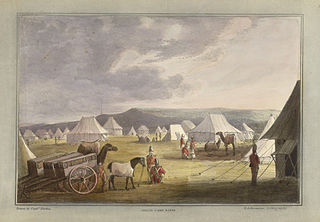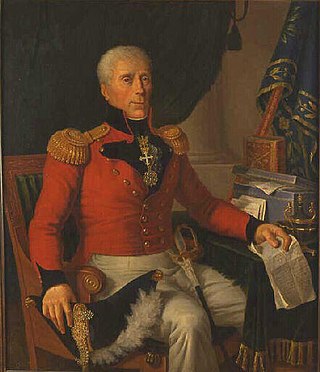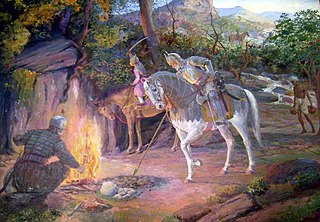
The Third Anglo-Maratha War (1817–1819) was the final and decisive conflict between the British East India Company and the Maratha Empire in India. The war left the Company in control of most of India. It began with an invasion of Maratha territory by British East India Company troops, and although the British were outnumbered, the Maratha army was decimated. The troops were led by Governor General Hastings, supported by a force under General Thomas Hislop. Operations began against the Pindaris, a band of Muslim mercenaries and Marathas from central India.

The Rajputana Agency was a political office of the British Indian Empire dealing with a collection of native states in Rajputana, under the political charge of an Agent reporting directly to the Governor-General of India and residing at Mount Abu in the Aravalli Range. The total area of the states falling within the Rajputana Agency was 127,541 square miles (330,330 km2), with eighteen states and two estates or chiefships.

Nagaur is a city and municipal council in Nagaur district of the state of Rajasthan in India. It is the administrative headquarters of Nagaur District. The Nagaur city lies about midway between Jodhpur and Bikaner.

Benoît Leborgne, better known as Count Benoît de Boigne or General Count de Boigne, was a military adventurer from the Duchy of Savoy, who made his fortune and name in India with the Marathas. He was also named president of the general council of the French département of Mont-Blanc by Napoleon I.

Rao Maldeo Rathore was a king of the Rathore dynasty, who ruled the kingdom of Marwar in present day state of Rajasthan. Maldeo ascended the throne in 1531 CE, inheriting a small ancestral principality of Rathore's but after a long period of military actions against his neighbours, Maldeo swept significant territories which included parts of present day Rajasthan, Haryana, Uttar Pradesh, Gujarat and Sindh. He refused to ally with either the Sur Empire or the Mughal Empire.

Raja Jaswant Singh I was the Rathore Rajput ruler of the Kingdom of Marwar in the western part of Rajputana modern day Rajasthan .He was a distinguished man of letters and author of noted literary works like "Siddhant-Bodh", "Anand Vilas" and "Bhasha-Bhushan".

Gwalior state was a semi-autonomous Maratha state. It was centred in modern-day Madhya Pradesh, arising due to the rise of the Maratha Empire and fragmentation of the Mughal Empire.

Shrimant Daulat Rao Shinde was the Maharaja (ruler) of Gwalior state in central India from 1794 until his death in 1827. His reign coincided with struggles for supremacy within the Maratha Empire, and wars with the expanding East India Company. Daulatrao played a significant role in the Second and Third Anglo-Maratha wars.

Maharaja Jawahar Singh was a Jat ruler of the Bharatpur State. He succeeded to the throne when his father Suraj Mal died in 1763.
The Battle of Patan was fought on 20 June 1790 between the Maratha Kingdom of Gwalior supported by the Peshwa & Holkar and the alliance formed by the Rajput Kingdoms of Amber, Kingdom of Marwar supported by Mirza Ismail Beg who betrayed Mahadji and joined the Rajput army in exchange for a promise of money. The battle resulted in a decisive Maratha victory.

Kingdom of Marwar, also known as the Jodhpur State under the British, was a kingdom in the Marwar region from 1243 to 1818 and a princely state under British rule from 1818 to 1947. It was established in Pali by Rao Siha, possibly a migrant Gahadavala noble, in 1243. His successors continued to struggle against regional powers for domination and 9 out of 15 rulers till 1438 died in combat. In 1395, its capital was changed to Mandore by Rao Chunda of Mandore and to Jodhpur in 1459 by Rao Jodha.
The Battle of Mandsaur took place in Mandsaur, India between the Maratha and Jai Singh II of Amber.
The Battle of Sammel, also known as the Battle of Giri-Sumel, took place in 1544. It was fought near the villages of Giri and Sumel, between the Afghan Sur Dynasty under Sher Shah Suri and the Rathore army led by the commanders Jaita and Kumpa of Rao Maldeo Rathore.
The Battle of Lalsot was fought between the Rajputs of Jaipur and Jodhpur against Marathas under Mahadji Scindia to collect taxes from the Rajput States. Mahadji as the Naib Vakil-i-Mutlaq of the Mughal Emperor, demanded Rs.63,00,000 from the Jaipur court, however these demands were refused, upon which Mahadji marched against Jaipur with his army. A part of the Mughal army under Hamdani deserted and defected to the Rajput army before the battle.
The Battle of Malpura took place in 1800 between the Kingdom of Amber and supported by the Kingdom of Marwar against the Maratha Kingdom of Gwalior. It was the result of a crisis between the governments of the two sides.

The Maratha Army was the land-based armed forces of the Maratha Empire, which existed from the late 17th to the early 19th centuries in the Indian subcontinent.
The Battle of Gangwana was a military engagement fought between the Kingdom of Marwar and a combined army of the Jaipur Kingdom and the Mughal Empire in 1741. The battle resulted in a peace treaty favorable to Marwar and ended a period of Jaipur domination in what is now present day Rajasthan.

Bakht Singh or Bakhat Singh was an 18th-century Indian Raja of the Rathore Clan. Born in 1706, he ruled over various domains in the Jodhpur and Marwar states and was a major political force during his life.

Described variously as the Rajput war, Rathore war of independence and Rathore rebellion, the conflict between Rajputs of Marwar and the Mughals started after the death of Jaswant Singh of Marwar, due to Aurangzeb's attempt to interfere in the succession of Marwar. The resistance to Mughal interference was started by the Rajput nobles under Durgadas Rathore and erupted into an all-out war between the Mughal empire and Rajputs of Marwar supported by Mewar Rajputs. It lasted for almost thirty years. The rebellion reached a climax after the death of Aurangzeb on 3 March 1707 and the capture of Jodhpur by the Rathores on 12 March 1707.
















